Page 206 of 516
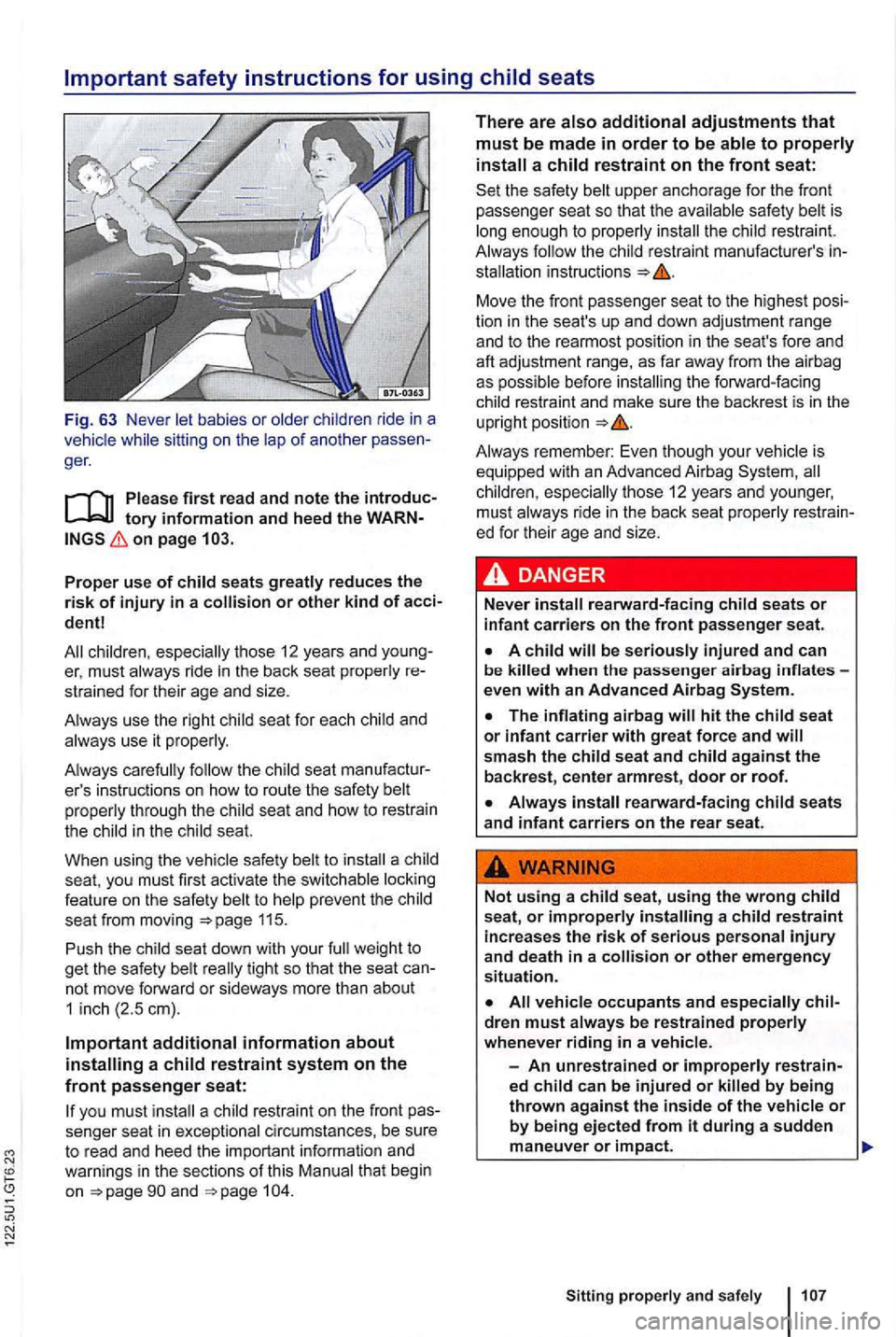
safety instructions for using
babies or ride in a of ano ther ger .
on page
seats or other kind of acci
dent!
seat for each use it
seat manufactur
er's instructions on how to route the safety through the in the seat.
When using
the to a
prevent the seat from moving
seat down with your tight so that the seat
a
a restraint on the front circumstances, be sure
to read and heed the important information and warn in gs in the sections of this 104 .
There are
the safety is enough to restraint manufacturer's instructions
Move the fron t passenger seat to the highest
restra int and make sure the backrest is in the
upright position
is
equipped with an Advanced Airbag System , especially those 12 years and younger,
must ride in the back seat restrained for their age and size.
be injured and can
be
even with an Advanced Airbag
against the backrest, center armrest, door or roof.
seat, using the wrong restraint increases the risk of serious or other emergency situation.
dren must be restrain ed
and
Page 207 of 516
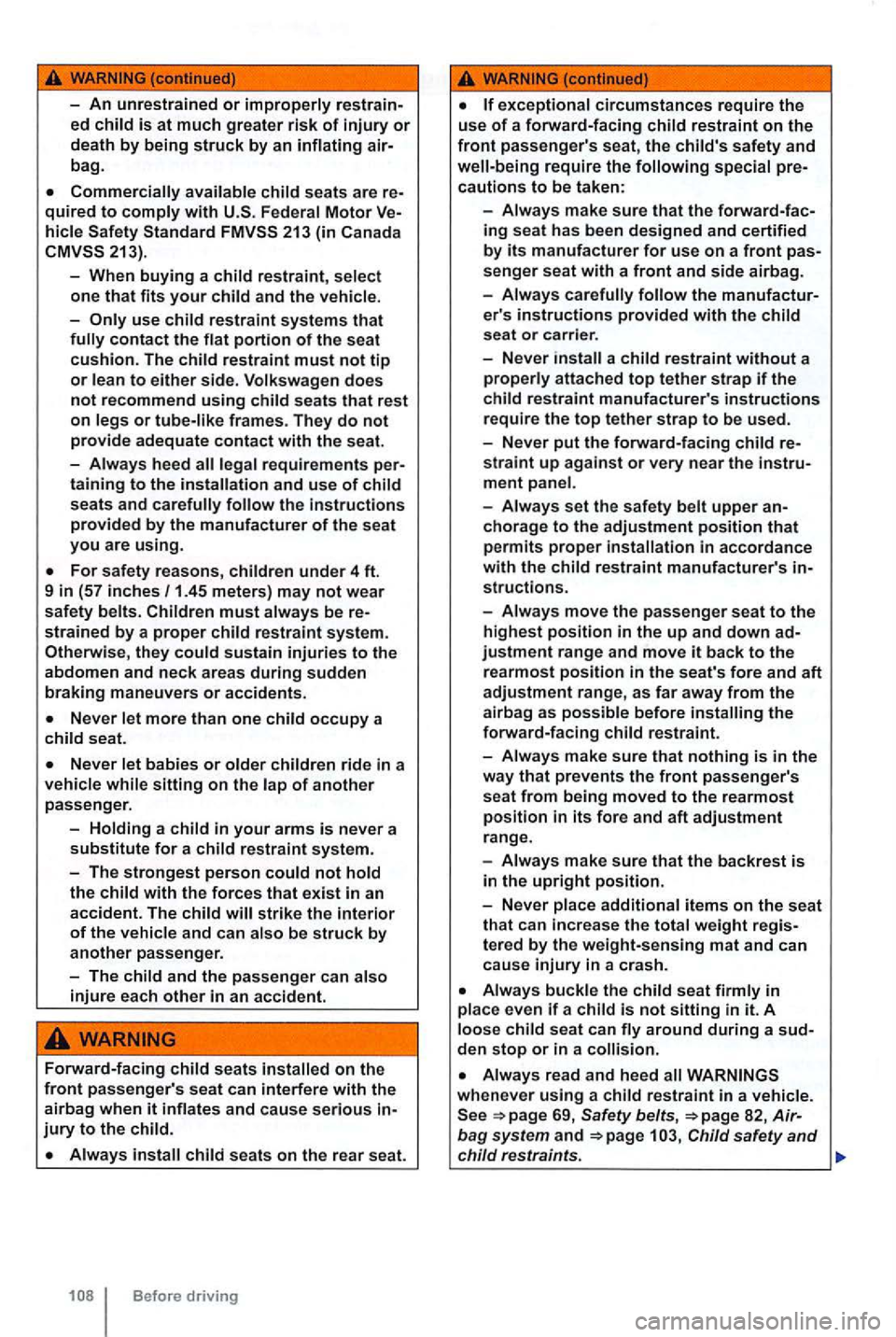
seats are re-quired to Motor Ve-
and the
restraint systems that
to either side. seats that rest on
seats and the instructions provided by the manufacturer of the seat you are using.
For safety reasons,
restrain t system. Otherwise, they sustain injuries to the abdomen and neck areas during sudden braking maneuvers or accidents.
occupy a
Never
a in your arms is never a substitute for a restraint system.
-The strongest person the strike the interior of the be struck by another passenger.
- The
injure each other in an accident.
Forward-facing on the front passenger's seat can interfere with the airbag when it and cause serious in-jury to the
seats on the rear seat.
(continued)
restraint on the front passenger's seat, the safety and
senger seat with a front and side airbag.
-
er's instructions provided with the seat or carrier.
- Never
a
straint up against or very near the
set the safety chorage to the adjustment position that permits proper
structions.
-
justment range and move it back to the rearmost position in the seat's fore and aft adjustment range, as far away from the airbag as
weight
even if a is not sitting in it. A around during a den stop or in a
restraint in a 82,
Page 209 of 516
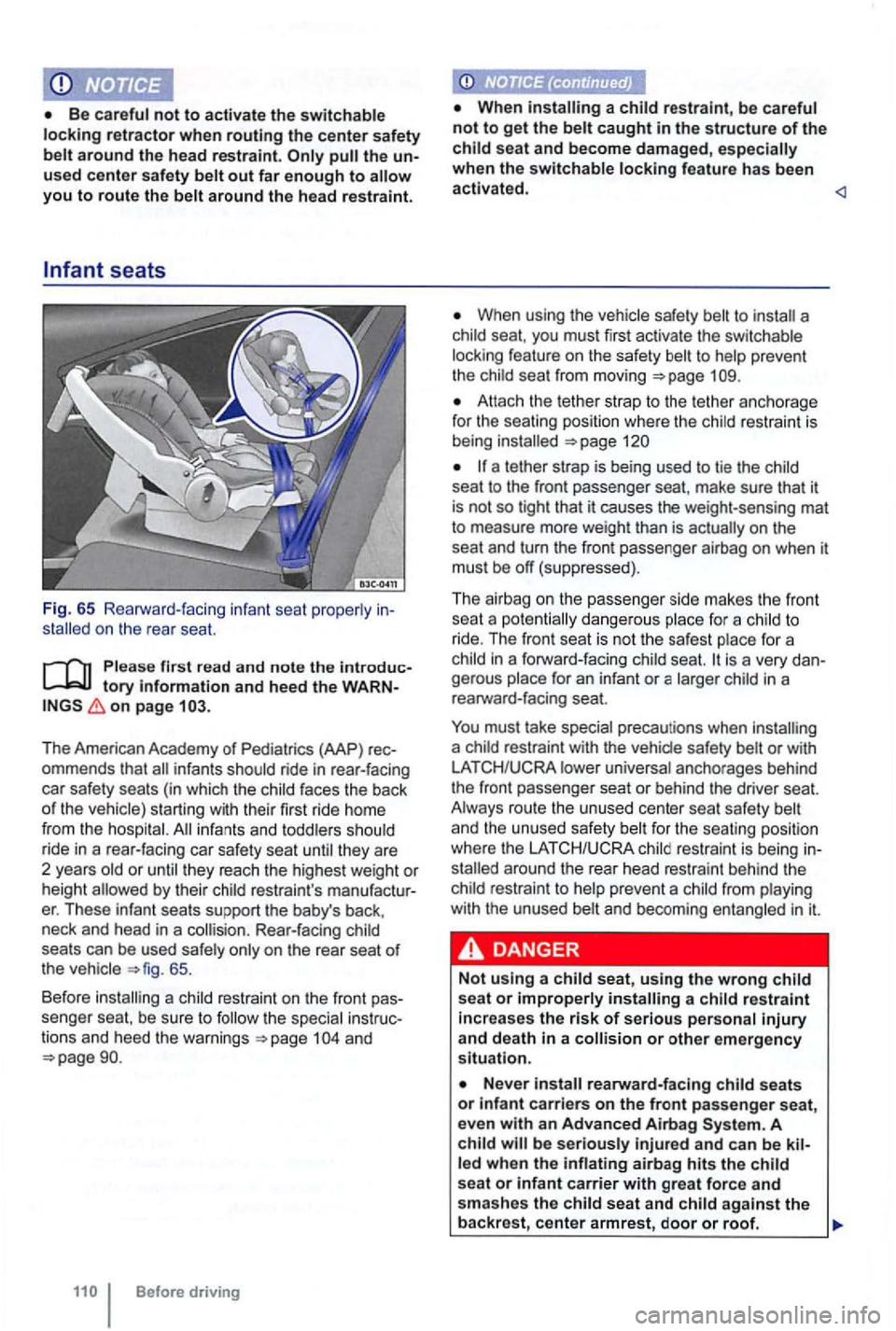
you to route the belt around the head restraint.
on the rea r seat.
on pag e
The American Academy of Pediatrics (AAP) ommends that infants shou ld ride in rear-facing
ca r safety seats (in whic h the child faces the back
o f the vehicle) starting wi
th their first ride hom e
from the i nfants and todd le rs s hould
r ide in a rea r-facing car safety seat until they are
2 years
Rear- facing child
seats can be used safely only on the rea r sea t of the vehicle 65 .
Before
a ch ild restrain t on the front senge r sea t, b e s ure to the specia l in str u c
t ions and h eed the wa rning s and
Before driving
. ,
When using the vehic le safe ty
to help prevent
the sea t from mov ing
a tether strap is being used to tie the child
seat to the front passenger seat, make sure that it
is not so tight that it causes the weig ht-sensing mat
to measu re more weight than
is actually on the
seat and turn the front passenger airb ag on when it
mus t be off (suppressed).
Th e ai r
bag on the passenger side makes the front seat a pote nti ally dangerous place for a ch ild to
ride. The fron t sea t is no t the safest place fo r a is a very gerous place for an infant or a larger
seat s or infant carriers on the fron t pas senger sea t,
eve n with an Advanced Airbag System. A child
again st the
b ackres t, center armrest, door or roof.
Page 213 of 516
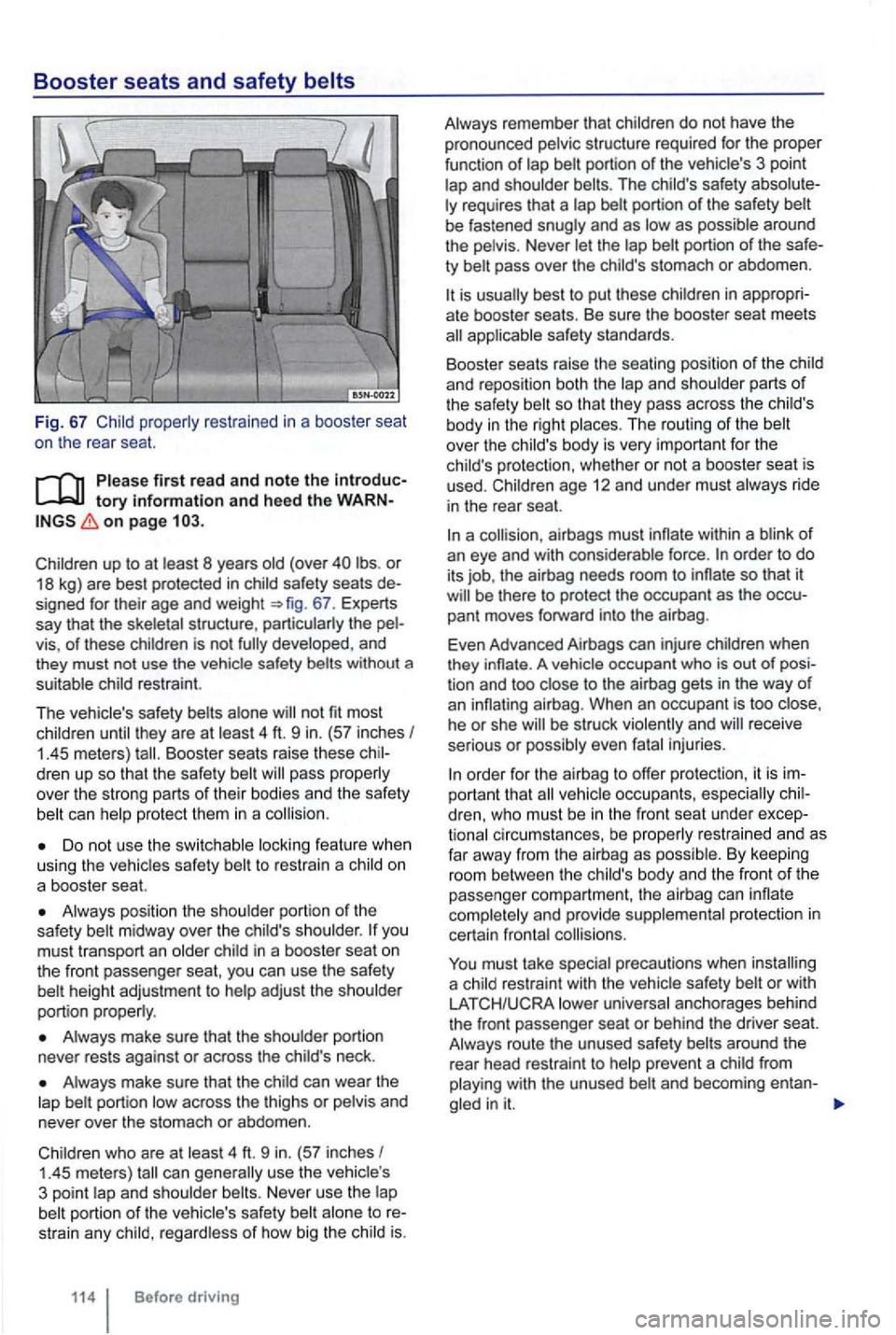
Booster seats and safety
first read and note the introduc
on page
or 18 kg) are best protected in
the vis, of these and
they must not use the restraint.
T
he not fit most
Booster seats raise these dren up so that the safe ty
can protect them in a
Do not use the fea ture when
u sin g the
midway over th e you must transport an
height adjustment to
make sure that the neck.
make sure that the across the thighs or
who are at 4 ft. 9 i n. (57 inches I 1.45 meters) can u se the 3 point and Never use the portio n of the to re
s train any of how big the is.
Before driving
remember that do not have the
pronounced
portion of the and The requires that a as Never the pass over the
is best to put these
and parts of
the safety body in the right The routing of the over the body is very important for the protection , whe ther or not a booster seat is
used . age 12 and under must ride
in the rear seat.
airbags must force. order to do its job, the airbag needs room to inflate so that it
he or she be struck receive
serious or
orde r for the airbag to offer protectio n, it is im
portant that
dren, who must be in the front seat unde r excepcircumstances, be restrai ned and as
far away from th e airbag as By kee ping
r oom between the
precautions when
route the unused safety arou nd the rear head restraint to prevent a from
in it.
Page 241 of 516
vided.
The ventilation slo ts between the rear dow and the luggage compartme nt cover
must not be blocked so that stale air can escape
from the veh ic le .
Folding the backrest of the rear seat forward and back into place
F ig . 83 Rear seat: release button red
Please first read and note the tory information and heed the on page 141.
The rea r seat backrest is di vide d into 2 sectio ns.
E ach sectio n of
the rear seat backrest can be to increase luggage space.
Folding the rear seat backrest forward
58.
the release button 83 forward
w hile folding the rear backrest forward.
142 Before driving
the rear seat backrest back until it es secu re ly
ed into place in order for the safety belts on the
rear seats to provide optimal protection.
Improper folding and improper latching of the rear seat backrest can cause serious
Page 242 of 516
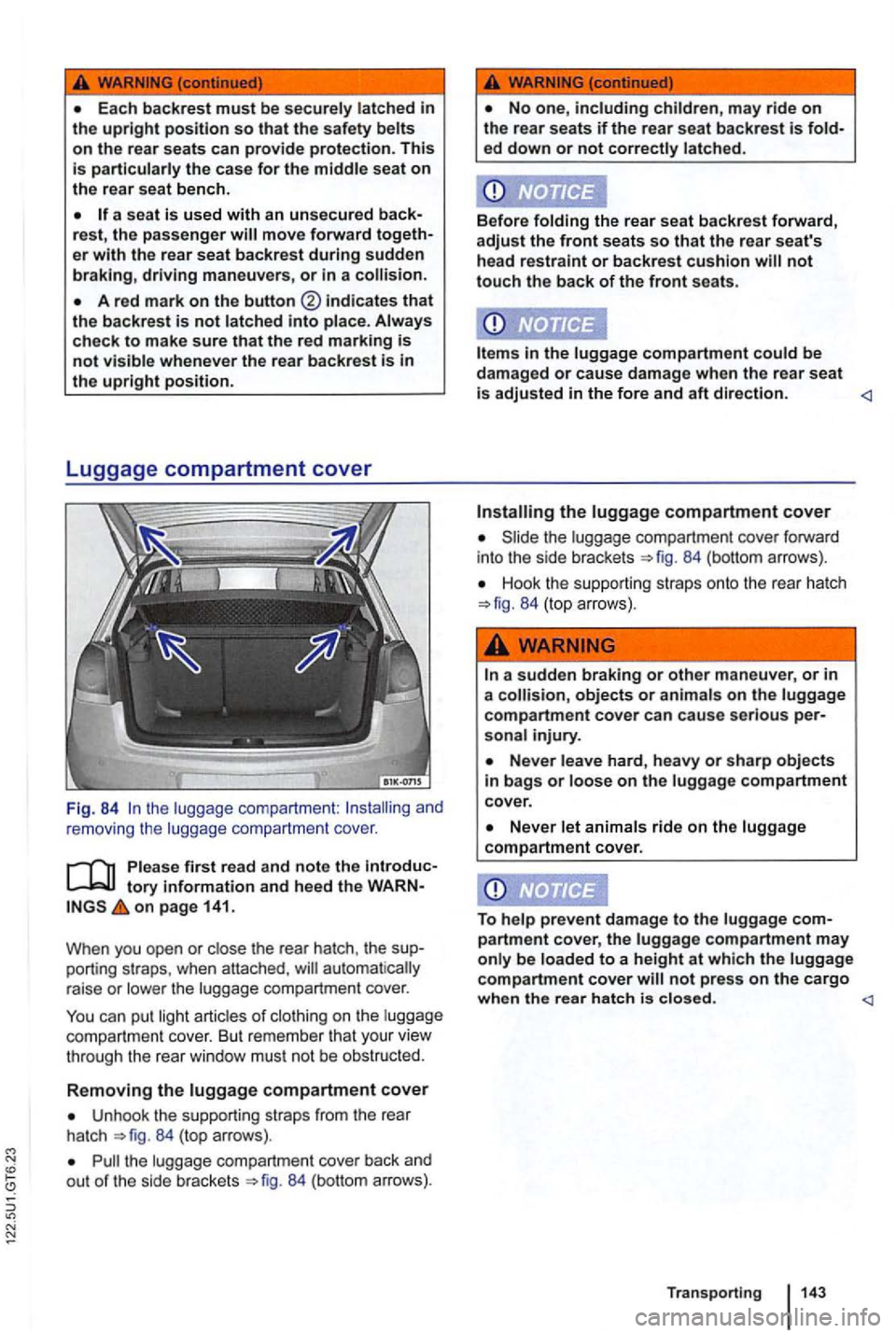
Each backrest must be the upright position so that the safety
a seat is used with an unsecured backrest, the passenger
A red mark on the button indicates that the backres t is not check to make sure that the red marking
compartment : compartment cove r.
first read and note the introductory on page 141.
When you open
or the rear hatch . the sup
porting str aps , when attached .
can put of
compartment cover
Unhook the supporting str aps from the rear
ha tch 84 (top arrows) .
84 (bottom arrows).
No one, may ride on the rea r seats if the rear seat backrest is ed down or not
Before the rear seat backrest forward, adjust the front seats so that the rear seat's head restraint or backrest cushion not touch the back of the front seats.
compartment
adjuste d in the fore and aft d irection.
the compartment cover
84 (bo ttom arrows).
Hook the supporting straps onto the rear hatch 84 (top arrows).
objects or animals on the compartment cover can cause seriou s injury.
Never hard, heavy or s harp objects
ride on the luggage compartment cover.
To prevent damage to the
to a height at which the
Transporting
Page 259 of 516
Storage compartment in the rear center console
Fig. 98
the luggage compartment:
on page 157 .
Storag e compartments in the luggag e compartment
Add itiona l storage compartments are located in the
sides of the luggage compartment. The side
els can be re m ove d by pushing upward in the rec tion of the arrow 99 to make room for er objects in the luggage compartment.
Before driving
on p ag e 157 .
T her e is a storage compartment for stowing
objects 98 in the back of the center conso le.
Additional storage:
Pockets in the back rests of the fron t seats .
ment 14 1.
C lothes or other items on the shelf behind the rea r sea t backres t m ay limit visibility, a nd
ca use acci dents a nd seve re person al injuries.
Alw ays ha ng c loth es so th at th ey do not lim it v isibility.
Page 281 of 516

Failure to heed warning lights or t ex t WARN-can result in vehicle damage .
Parking brake
Fig. 113 Between the front seats :
on page 179.
the parking brake lever up firmly.
When the ignition is on , the indicator or appears in the instrume nt c luster display to show th at the park ing brake is engaged
the leve r up 113 (arrow) .
While hold ing the release button down, move
t h e lever t he way down.
Parking
Ple ase firs t r ea d and note the introductory info rm ation and heed the WARNon pa ge 179.
note legal regulations when stopping and
parking your vehicle.
Parking the vehicle
p erform these steps only in the order listed.
the vehicle on a suitab le surface
the rear wheels are braked . Always
use the foot bra ke.
engag ed. This c an cause the brak e to over
heat and neg ati vely affec t the b rak e sys te m .
start to move even if the parking brake is e ngag ed .
Even
though the tra nsmission is in P ark (P),
t h e vehi cle may move a couple of inche s (a fe w
c entimeters) forwards or backwards if you take
your f oot off the brake pedal after stopping the
ve hicl e without fir s t firmly setting the parking
b rake .
A warning signal sounds if you drive faster
Apply t he parking brake to 182.
For automatic transmissions : (P).
Remove the vehicle key from the igni tion.
necessary , turn the steer ing whee l to
e ngage the steer ing column lock.